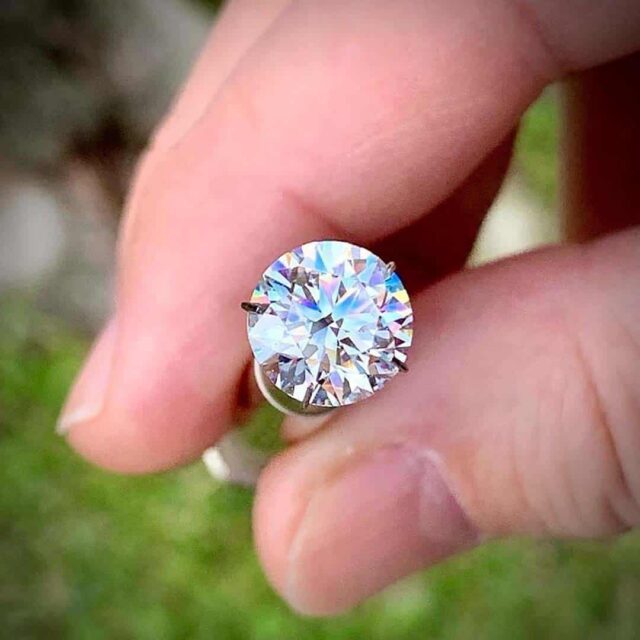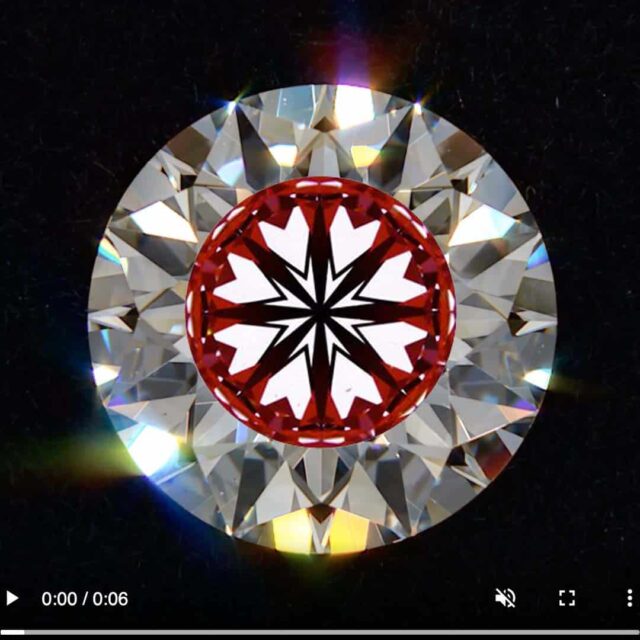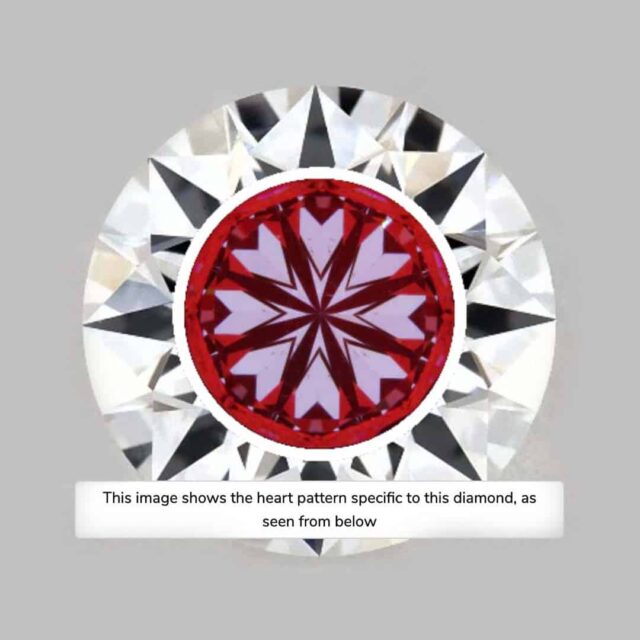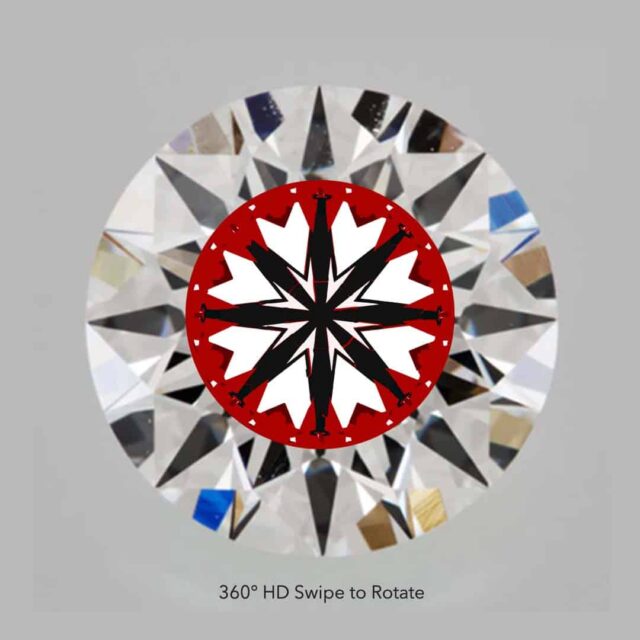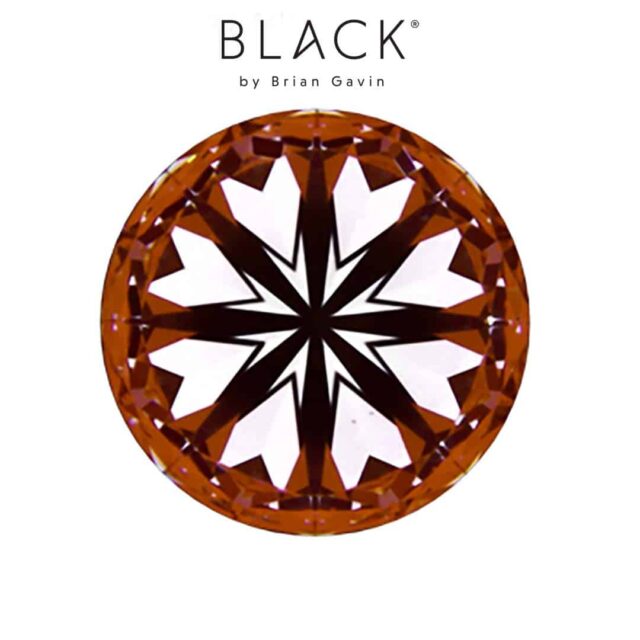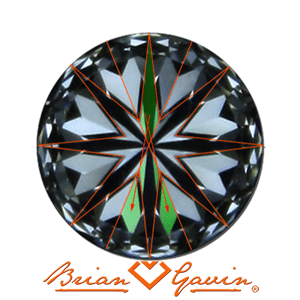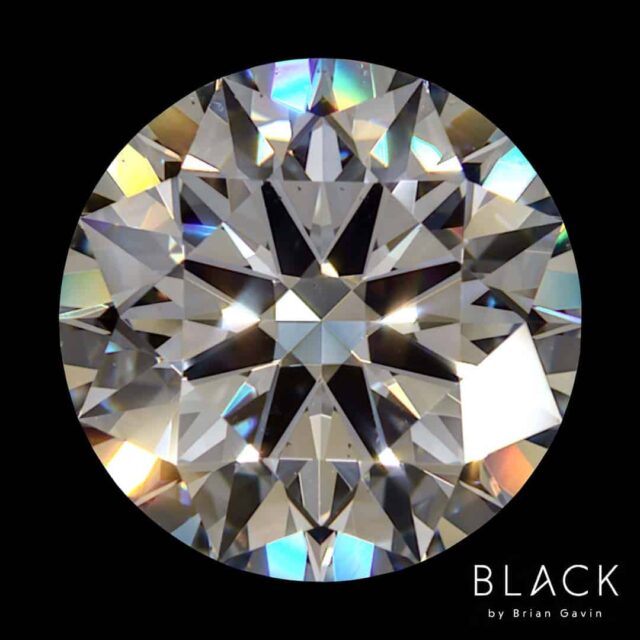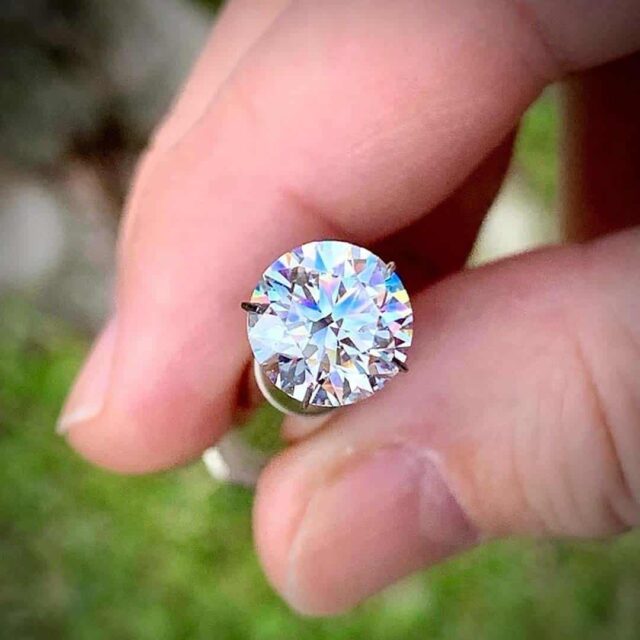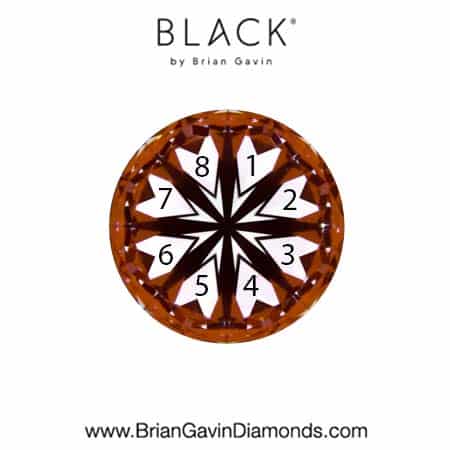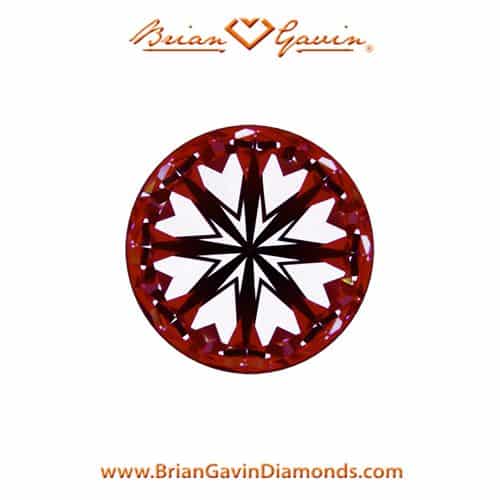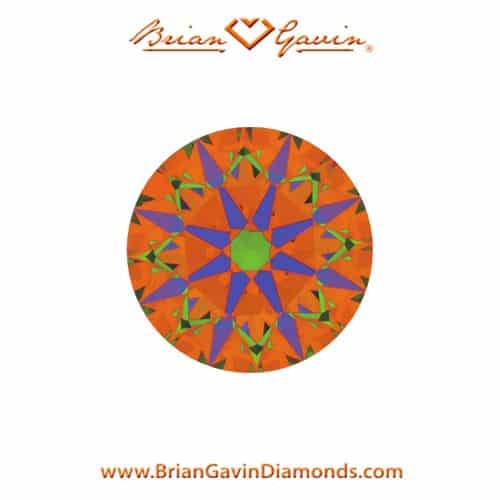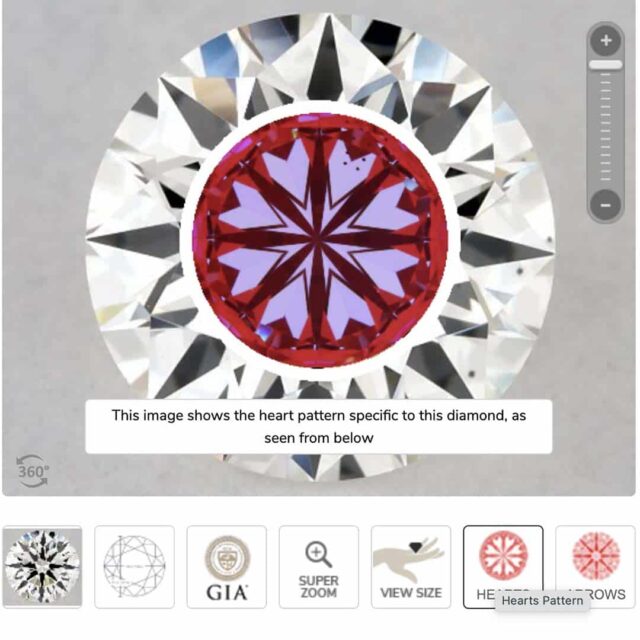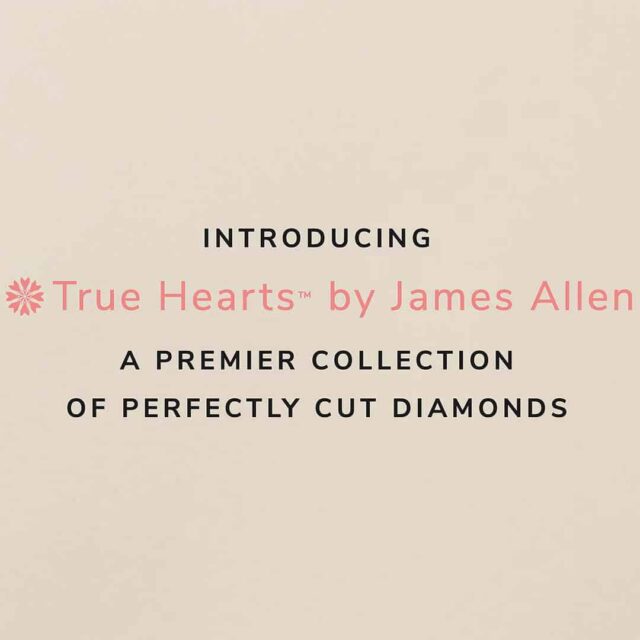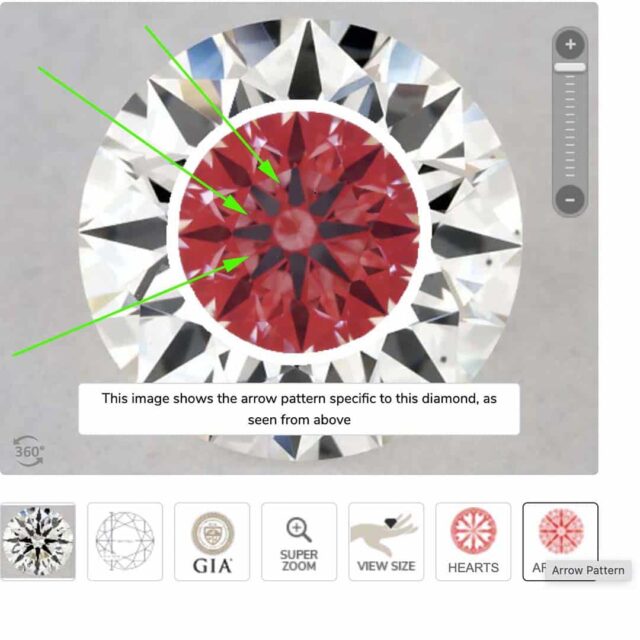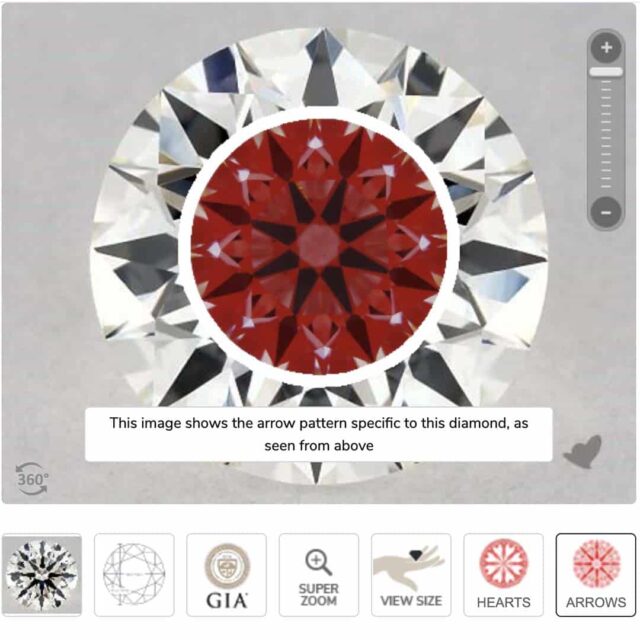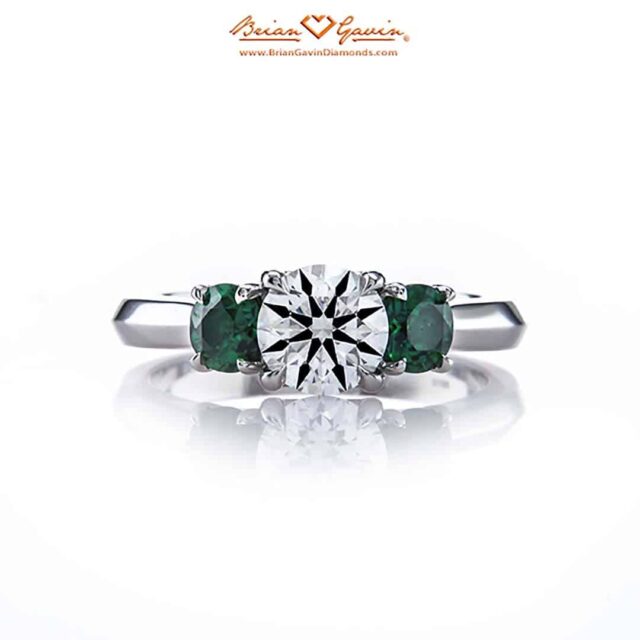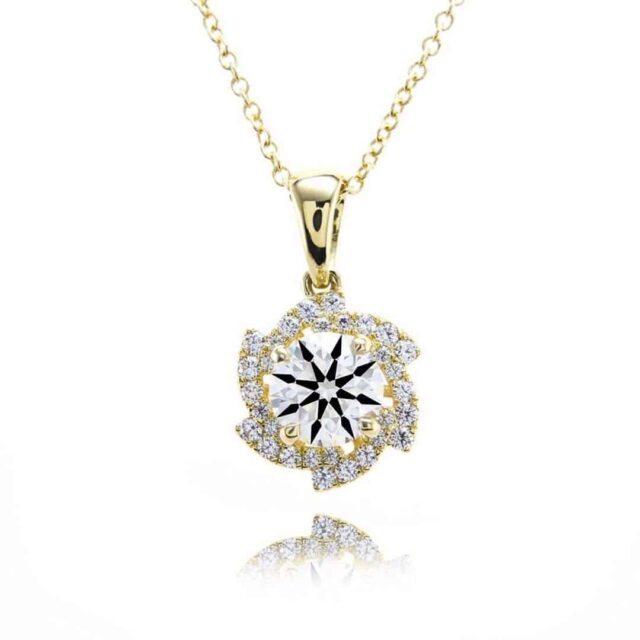Hearts and Arrows diamonds exhibit the highest volume of light return and most vivid and intense sparkle. As a matter of fact, they have only been available since the mid-1990s. Here are some examples from our favorite places to buy H&A diamonds:
While people tend to be mesmerized by the hearts pattern, it's the sparkle factor of these diamonds that is truly remarkable. Be that as it may, the hearts pattern is a reflection or indication of the degree of optical precision. That is the consistency of facet shape, size, and alignment.
Consequently, the combination of proportions and the higher degree of optical precision is like a turbo charger for sparkle. As a result, these puppies offer a degree of light return and visual performance that is off the charts!
The Superior Sparkle of Hearts and Arrows:
Black by Brian Gavin
Black by Brian Gavin Hearts and Arrows Diamonds represent the pinnacle of diamond cutting today.
James Allen True Hearts
James Allen True Hearts diamonds are extremely popular with millennials and offer a good value proposition.
Victor Canera H&A
Victor Canera offers an extensive selection of hearts and arrows diamonds and hand-forged jewelry.
Hearts and Arrows Diamonds Photographs:
In the first place, all of the images contained herein are actual photographs of hearts and arrows diamonds. In other words, they are not computer-generated renderings, drawings, or illustrations. In addition, the photographs have not been edited beyond the insertion of reference points for illustration purposes.
With that in mind, it's somewhat amusing how some jewelers try to deny the existence of hearts and arrows diamonds. Or, how they might try to convince you that the H&A diamond phenomena is simply a matter of smoke and mirrors.
Because there is nothing mythical, nor make believe about the incredible sparkle factor of hearts and arrows diamonds. As a matter of fact, they are very real, but they are also extremely rare.
Not "I believe in Unicorns” rare, mind you... But, rare enough that only 0.001% of the average annual production of rounds meets the criteria for hearts and arrows diamonds. Under those circumstances, the Brian Gavin Signature diamond on the left is quite special indeed.
Where to Buy Hearts and Arrows diamonds:
Hearts and Arrows diamonds have been available on the open market since the early 1990s. Consequently, they have been the focus of numerous articles in publications like: National Jeweler Magazine, Modern Jeweler Magazine, and Jewelers Circular Keystone.
As a matter of fact, Hearts and Arrows Diamonds are available under a variety of brand names:
However, it's important to evaluate the options available and consider each of them carefully. That's because hearts and arrows diamonds are turned on the wheel by hand. Under those circumstances, each of them is as unique as a snowflake and will have its own personality. In that case, there will be differences in the degree of light performance and sparkle factor as shown below.
Creating Hearts and Arrows Diamonds:
A "Hearts and Arrows Diamond” is a round brilliant cut diamond that exhibits a crisp and complete pattern of Hearts and Arrows when viewed while unmounted through a special scope which is designed to diffuse the light and reflect white off of the high contrast areas of the diamond and magnify it so that it can be seen.
It might be difficult to believe that a crisp pattern consisting of eight perfectly formed Hearts & Arrows could be present and visible within a round brilliant cut diamond.
Patterns of Hearts and Arrows within round brilliant cut diamonds are formed by light reflecting off of the eight pavilion main facets, across the diamond on to the lower girdle facets.
Then it is split apart into two halves of a heart by the pavilion main facets located on the opposite side of the diamond. This is shown in the illustration on the left that is provided by master diamond cutter Brian Gavin.
In this case, the pavilion main facets are outlined in orange. And shows the light (green) reflecting off of the pavilion main facet in the 12 o’clock region, across the diamond.
Where it reflects off the lower girdle facets located in the six o’clock region to create two halves of a heart shape; the pattern repeats from one set of facets to the next to complete the pattern.
Carefully Planned Optical Precision:
It is quite literally impossible to produce a Hearts and Arrows Diamonds by accident and only the most skilled of diamond cutters are capable of producing a diamond to such exacting standards.
The secret to creating a spectacular hearts and arrows diamonds is in the creation of the lower girdle halves of the pavilion section. Those sixteen facets must be indexed precisely and all cut to exactly the same length and angle. Or, the pavilion main facets that separate each pair of lower girdle facets will vary in size and shape. That will result in twisted misshapen hearts and crooked arrows.
Each section or facet group is critical to the creation of a crisp and complete pattern of hearts and arrows. As such, they must be carefully cut to be equal in size, shape and alignment. Even the tiniest of facets can substantially impact the appearance of the hearts and arrows pattern.
If it is slightly off in "angle symmetry” or indexing (placement) it will result in imperfections in the pattern. At the same time, it will create variations in contrast brilliance and result in light leakage or obstruction. Of course, all of the facets in a facet group should fire at the same time. In that case, they will reflect the white sections within the hearts and arrows diamonds viewer equally.
Proportions of Hearts and Arrows Diamonds:
As you might imagine, the proportions of the diamond are also an integral part of the creation of hearts and arrows diamonds. In that event, you'll find more precise patterns within a specific range of proportions. That is why we prefer a pavilion angle between 40.6 - 40.9 degrees for round diamonds. And that should be offset by a crown angle between 34.3 – 34.9 degrees.
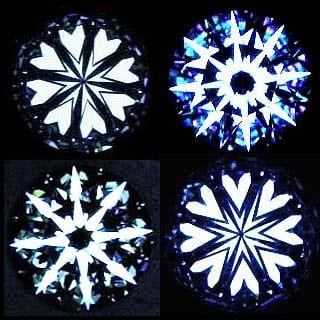
Variations in H&A Patterns, Circa 1999.
Relatively decent, but technically imperfect patterns of hearts and arrows are often produced at the outer edges of this range. Perhaps they were produced by diamond cutters who are more intent on retaining diamond carat weight than sparkle factor.
In other words, diamonds that exhibit patterns of "hearts and arrows” can be found along the outer fringes of the center range of the zero ideal cut proportions region. However, the patterns tend not to "POP” or be as VIVID as those cut to the tighter range of proportions.
And more often than not, they exhibit a pattern that looks more like the "spears and rabbit ears” or "lawn darts.” Consequently. an example of that outcome appears on the left. Clearly Cupid's Hearts & Arrows missed the mark on the right (by a long shot).
Diamond Cut Precision = Super Sparkle Factor:
The pavilion section of a diamond is the lower half, it is the primary reflective surface. The angle of which will dictate the volume of light return exhibited by the diamond. In order to maximize the volume of light return , I recommend a pavilion angle between 40.6 – 40.9 degrees.
The balance of brilliance (white sparkle) and dispersion (colored sparkle or fire) is primarily dictated by the crown angle. Of course, the crown height of the diamond is also a contributing factor. and crown height. I'm going to assume that you want to see a virtual balance of brilliance and dispersion. In that case, you should keep the crown angle between 34.3 - 35-degrees.
The lower girdle facet (LGF) length of the diamond will affect the size and intensity of the sparkle exhibited by the diamond. Obviously, this works in conjunction with the overall proportions of the diamond. Assuming the proportions above are present, then the lower girdle facet length will have the following effect:
If the LGF is between 75 - 78%, then the arrows pattern will be well-balanced and it should produce broad-spectrum sparkle. That is sparkle factor that is larger in size, and that is bolder, brighter, and more vivid. Than what tends to be produced by Lower Girdle Facets of 80% or more. That's because 80% LGF tends to produce thinner looking arrows and pin-fire sparkle that is smaller and less intense.
The problem with smaller pin-fire type sparkle is that it can be difficult for our eyes to disperse smaller flashes of white light into colored light/fire. That is why I prefer the broad spectrum sparkle created by LGF’s in the range of 75 – 78%. It might not surprise you to learn that the majority of Brian Gavin Signature diamonds have 75 – 78% LGF.
Optical Precision the Key to Light Performance:
Those of us who specialize in the niche of Hearts and Arrows diamonds tend to talk a lot about optical precision. That is the consistency of facet shape, size, and alignment from the perspective of 360-degrees.
Consequently, this is sometimes described as optical symmetry. In that case, people tend to confuse optical precision with the meet-point symmetry grade on the lab report. Suffice to say that they are completely different things and that is why we say that GIA Excellent may not be good enough.
The majority of diamond grading laboratories relied on by the trade do not take optical precision into account. That includes the GIA Gem Trade Laboratory, and the American Gem Society.
The symmetry and alignment of a diamond’s facets are what control scintillation which is the movement of light inside of the diamond. The inside of a diamond is similar to a round room made of mirrors.
When cut properly those "mirrors” reflect light out the top of the stone towards the observer. And exhibit a crisp pattern of hearts and arrows like the Black by Brian Gavin Diamond on the left. On the other hand, if the mirrors are not properly aligned, then they reflect light out the sides of the stone and it leaks light.
Factors of Optical Precision:
As stated previously, the term optical precision refers to the consistency of facet shape, size, and alignment. Consequently, it is easy to confuse this concept with the diamond symmetry grade on the lab report. On the one hand, the two factors of diamond cut quality do share some common traits.
For example, poorly cut diamonds may be out of round and that is an issue of both optical precision and symmetry. In addition, there may be facets that are misaligned or misshapen. There might also be facets that fail to point towards one another. Or, there may be facets that don't align properly with the facets on the other side of the stone.
As a matter of fact, all of those issues are characteristics that are part of the diamond symmetry grade. At the same time, they are all factors that may contribute to light leakage or sparkle factor that lacks luster. In that case, it might be easier to think of optical precision as the next level beyond basic symmetry. Because it represents a degree of precision that is well beyond what the gemological laboratories take into account.
Under those circumstances, it's fair to say that there are different levels of performance within the realm of ideal cut. As a matter of fact, that makes sense because there is a broad range of proportions for that rating. In that case, you'll see varying degrees of performance within the spectrum of ideal cut diamonds.
Classifications of Ideal Cut Diamond Performance:
- 1Ultra Super Ideal Cut Hearts and Arrows Diamonds, e.g. Black by Brian Gavin.
- 2Super Ideal Cut Hearts and Arrows Diamonds, e.g. Brian Gavin Signature.
- 3Hearts and Arrows Diamonds, e.g. James Allen True Hearts.
- 4Standard AGS Ideal & GIA Excellent, e.g. Astor by Blue Nile.
Hearts and Arrows Diamonds Are Rare:
In terms of light performance, a standard ideal is likely to be within the Top 1% of the annual production for round diamonds. At least if it has the proportions I recommend and an overall cut grade of AGS Ideal/GIA Excellent. Whereas the hearts and arrows diamonds are more like the Top 0.001%.
One of the primary differences between the classes of cut quality is the degree of light return and sparkle factor. As a matter of fact, it requires a higher degree of optical precision to create the hearts pattern.
Consequently, that will produce more virtual facets within the diamond. Those are the internal reflections of light that are similar to a kaleidoscope effect. In turn, that produces more outward bound sparkle and it will be more vivid and intense.
That is one of the reasons why the Black by Brian Gavin Hearts and Arrows Diamonds are so impressive. As a matter of fact, that's why we chose one for my son's engagement ring. And you do realize that our trade status enables us to buy direct from practically any cutter in the world, right?
Examples of Poor Optical Precision:
The photographs of ideal cut diamonds below were taken through our imaging system in 1999. One of the reasons that we're still using them is because help to demonstrate the progression of diamond cutting.
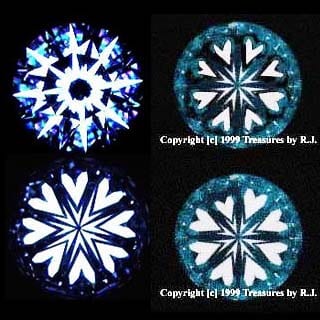
Ideal Cut Diamonds, NOT Hearts and Arrows.
After all, these photographs were taken shortly after Hearts and Arrows diamonds were first introduced. At that time, the patterns on the left were pretty typical of the ideal cut diamonds available at the time.
Whereas it's not uncommon to see some sort of hearts and arrows pattern in ideal cut diamonds today. Although that may be true, it's unlikely that you'll find a standard ideal that exhibits a good pattern.
That's because careful planning and skill are necessary to produce a crisp and complete pattern of hearts and arrows. In other words, it's not something that occurs by accident.
"Lawn Darts and Rabbit Ears"
In the case above, the diamonds exhibit some hearts, but they lack consistency in size and shape. As such, they are not what we consider to be hearts and arrows diamonds. In fact, we wouldn't even recommend them as a standard ideal cut diamond. That's because light is not reflecting evenly as a result of poor optical precision.
Consequently, we adhere to the hearts and arrows diamonds grading standards of the Zenhokyo and Central Gemological Laboratory. Those are the two H&A diamond grading authorities of Japan who were at the forefront of development. As a matter of fact, their grading scale allows for extremely minor variances in pattern precision. That is because these diamonds are turned on the wheel by hand.
Hearts and Arrows Diamonds = Best Visual Performance:
As you're probably beginning to realize, the presence of a hearts pattern does not guarantee optimum light performance. Consequently, the hearts pattern is a reflection of the basic facet structure for every modern round brilliant cut diamond. Under those circumstances, it's possible for any round diamond to exhibit some sort of hearts pattern.
Although that may be true, fewer than 0.001% of rounds qualify as hearts and arrows diamonds. At least based on the average annual production volume and our strict grading standards.
The reason is because it requires an extreme degree of optical precision to really nail the hearts pattern. That's problematic for cutters for several reasons. Not the least of which is that it requires a high degree of skill and specialized equipment.
But also, because it can take up to 4X longer to polish a diamond to reflect the higher degree of optical precision. Needless to say that "time is money" and a lot of cutters simply aren't willing to invest that much to turn out their production.
Be that as it may, we certainly appreciate the visual benefits of hearts and arrows diamonds. After all, the Black by Brian Gavin Diamond on the left sparkles like the sun. And isn't that the type of light performance that you have in mind?
The Most Vivid & Intense Sparkle Factor:
As a matter of fact, hearts and arrows diamonds exhibit the most vivid and intense sparkle factor you'll ever see. Consequently, that's not just my educated opinion based on 35+ years of experience as a diamond buyer. Because it also reflects the findings of an in-depth brilliance study conducted by the American Gem Society Laboratory.
In that case, the AGSL determined that the higher degree of optical precision produces more virtual facets within the diamond. Those are the "virtual facets” that are created by the overlapping of actual facets. As a matter of fact, they factor into scintillation because they're created on the fly as you rock a diamond back and forth.
In that event, you'll create scintillation via the virtual facets as the diamond is moving. And those virtual facets will blink in and out of existence as the diamond continues to move. Under those circumstances, a higher number of virtual facets is going to produce more sparkle. And that sparkle will be even more vivid and intense given the right proportions and degree of optical precision.
How do I love thee? Let me count the ways:
While this has nothing to do with light performance, those cute little hearts can help out in the romance department. That is if you take a moment to assign a special meaning to each of the hearts.
In other words, take it from 19th century poet, Elizabeth Barrett Browning and count the ways you love her. For extra credit, try to make the meaning specific to your relationship. There is something "memorable” that you’ve done at least eight times, right?
By the way, the very first hearts and arrows diamonds were known as Cupid's Arrows Diamonds. In that case, they spent a lot of time and effort marketing the benefits of the Cupid's Arrow Effect. Under those circumstances, giving each of the hearts a special meaning is not as froufrou as it sounds.
All right, maybe it is, but I’m telling you that it's well worth the time and effort that it will take you to whip this up in Photoshop. After all, she's going to goo and gush, and get all weepy-eyed, and that's going to score you a Ton of Dog Points! Trust me, you're going to need them later.
One of our clients incorporated pictures of their Brian Gavin Signature diamond into their wedding invitations and RSVP cards. You can also read more about that in The True Significance of a Diamond Engagement Ring.
"Where Do Hearts and Arrows Diamonds Come From?"
Thankfully, this is much easier to answer than the where do baby’s come from query. Although that may be true, you'll still get the same look of "uh” that a five-year-old gets from Daddy when posing this question to most retailers. In fact, if you really want to have fun, just ask them to explain how the hearts pattern is formed.
Obviously, I've got a knack for bringing out the best in people. You should hear some of the stories that clients tell me about their Adventures in Diamond-landia. Speaking of which, you'll get a kick out of the time I secret shopped Tiffany & Co.
Be that as it may, the first hearts and arrows diamonds emerged on the market in the early 1990s. Rumor has it that a Japanese businessman ran across the concept of Hearts & Arrows as part of an investment scheme. In other words, he was approached by an inventor who was looking for venture capital investment. As luck would have it, the guy invented the scope that we now use to evaluate optical precision.
What Came First, the Scope or the Diamond?
Consequently, the Japanese businessman was not in the least interested in the scope. However, he was intrigued in the sample diamond because it exhibited an eight-pointed star. As a matter of fact, the star pattern reminded him of the Eight Noble Paths of Buddhism.
For that reason, it didn't take long for Hearts and Arrows diamonds to become popular in Japan. Under those circumstances, the law of supply and demand drove many diamond cutters to turn their wheels in a new direction. Although we didn't know about it for many years because their production was only available in Japan.
As a matter of fact, we didn't even know that hearts and arrows diamonds existed until the Yen collapsed in the 1990s. That's when hearts and arrows diamonds were first introduced to the U.S. market. We became a point of distribution because we already specialized in the niche of ideal cut diamonds.
In that case, we were one of the first companies to offer hearts and arrows diamonds in the United States. So, I might know a little bit about the subject (read that sentence as if it were dripping sarcasm because it is).
Brands of Hearts and Arrows Diamonds:
The "Brand Name" identifies the seller, but it not necessarily an indication of consistent quality.
At the present time, there are several companies selling different brands of hearts and arrows diamonds. In my experience, people tend to clump H&A diamonds into one group.
In other words, they wrongfully assume that all hearts and arrows diamonds are created equal. As if somehow the mere existence of a hearts and arrows pattern creates better light performance.
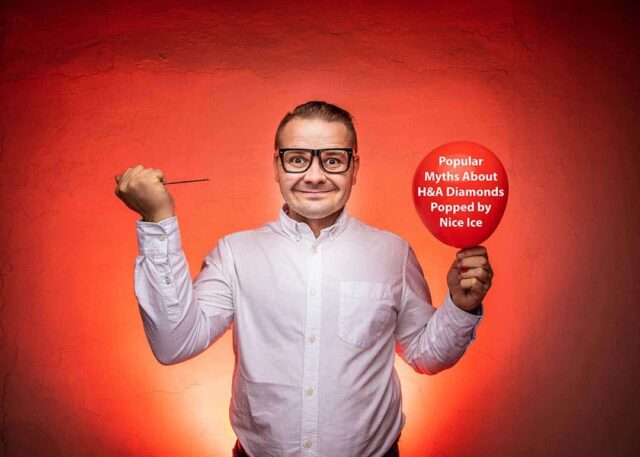
Shattering Myths About Hearts and Arrows Diamonds.
Far be it from me to burst your bubble, but balloons are bursting all around. Because I'm about to POP some myths about hearts and arrows diamonds.
Not the least of which is that they're all the same because they're not. And perhaps the best example of that statement is demonstrated by the different classifications of hearts and arrows diamonds within the Brian Gavin collections.
In the first place, Brian Gavin is a fifth-generation cutter who specializes in the niche of hearts and arrows diamonds. Consequently, he's also holds the only patent for maximizing light performance in the modern round brilliant.
In that case, the goal is to polish every H&A diamond to the specifications of the Black by Brian Gavin collection. However, that's not always possible for a variety of reasons including the rough might not yield itself to that degree of optical precision.
Black by Brian Gavin vs Signature:
Under the circumstances above, a diamond might not qualify for placement in the Black by Brian Gavin collection. In that case, it might be placed in the Brian Gavin Signature collection of hearts and arrows diamonds. Although the difference in optical precision might be extremely minute from the perspective of the average person.
As a matter of fact, the 1.054 carat, G-color, VS-2 clarity, Brian Gavin Signature diamond above didn't make the cut for Black. This is a good example of the differences between the brands of hearts and arrows diamonds. After all, the selection criteria for Black by Brian Gavin Diamonds is VS-2 and higher in clarity and G+ color with negligible fluorescence.
In that case, this H&A diamond meets the selection criteria in terms of diamond clarity and the color grade. Consequently, that means that the reason it didn't make it into the Black collection is a matter of optical precision. In that event, you'll want to study the Hearts Pattern on the left and the ASET Scope image on the right very carefully.
As a matter of fact, that is exactly what I did and it took me a minute to determine why this isn't a Black by Brian Gavin Diamond. In the first place, the reason why this isn't a Black is not very easy to see even with the ASET and H&A Scope images. Secondly, it's not something that we're likely to see with just our eyes, but Brian Gavin Is a Cut Nut. [Yeah, imagine that coming from me.]
Can you see the reason why this Brian Gavin Signature diamond isn't a Black? I'll give you a hint, it's a reflection of the fine-tuning of the minor facets. Nope? That's not enough? All right, follow the yellow brick road (but in it's green in this case). In other words, it's the slight variation in the green outline that borders the star facets.
James Allen True Hearts and Arrows Diamonds:
Another very popular brand of hearts and arrows diamonds is James Allen True Hearts. As shown below, they market their diamonds from the perspective that they are perfectly cut:
The 1.13 carat, I-color, VS-2 clarity, James Allen True Hearts diamond shown above exhibits a nice looking hearts pattern. At the same time, the proportions are within the range I recommend as confirmed by the diamond grading report from the GIA. In that case, the diamond should exhibit a high volume of light return and a virtual balance of brilliance and dispersion.
However, the red (arrows) Ideal Scope image on the right indicates a moderate amount of light leakage. As evident by the light pink semi-transparent sections that are highlighted by the green arrows. In light of that evidence, I would argue that this particular James Allen True Hearts diamond is not perfectly cut.
Picking the Best From the Rest:
It doesn't take a Rocket Scientist to see that the Ideal Scope image for this James Allen True Hearts diamond looks better. In that case, I would choose this 1.13 carat, I-color, VS-2 clarity, James Allen True Hearts diamond over the one above.
In the first place, the Ideal Scope image on the left shows less light leakage. Secondly, it shows a more even distribution of hue and saturation under the table facet. At the same time, the diamond grading report from the GIA confirms the proportions are within the range I recommend.
In that case, it's clear that this James Allen True Hearts diamond is more perfectly cut than the other. Under those circumstances, it is the better choice of the two diamonds if you're looking for a a 1-carat diamond ring.
Although that may be true, the point that I'm trying to make is that there are differences between hearts and arrows diamonds. Even within the scope of a brand that promotes the idea that their diamonds are perfectly cut.
Rather than argue the validity of such things, it's more prudent to simply be aware of the differences. Because then you can focus on finding the best hearts and arrows diamonds within each collection.
Popular Brands of H&A Diamonds:
As shown above, there are bound to be differences in light performance within the realm of hearts and arrows diamonds. In the first place, there are differences in production quality as it pertains to optical precision. As you will recall, that is the consistency of facet shape, size, and alignment from the perspective of 360-degrees.
At the same time, there are differences in the degree of consistency to be found within each brand. As a matter of fact, those differences might include the range of proportions and light performance.
But, when it comes to Brian Gavin, it's almost as if he stands in a league of his own. After all, he is the only cutter in the world with a patent for maximizing light performance in the modern round brilliant cut diamond.
Be that as it may, I recommend that you consider these popular brands of hearts and arrows diamonds:
Begin by searching their inventory for H&A diamonds within the range of characteristics and price you are looking for. Obviously, you want to eliminate any with proportions outside the range I recommend. Then eliminate anything that shows light leakage under the table facet or more than slight variations in the degree of optical precision.
In other words, you'll use the reflector scope images to determine the best options. Of course, you should take advantage of our free Diamond Concierge Service. After all, I've been doing this for 35+ years and I can help you pick the best options available.
Hearts and Arrows Diamonds & Snowflakes:
It's been said that no two snowflakes are alike. Needless to say, that we can say the exact same thing about hearts and arrows diamonds. After all, each of them is turned on the wheel by hand and there are bound to be differences as a result.
Throughout the years, I've had the privilege of personally evaluating literally 10s of thousands of hearts and arrows diamonds. Not only from the perspective of a professional diamond buyer. But, also, from the perspective of a being a well-known trade consultant in the niche of light performance.
Under those circumstances, it's obvious that I can buy direct from practically any diamond cutter in the world. Thereby, it should come as no surprise, that we chose a Black by Brian Gavin diamond for my son's engagement ring.
As a matter of fact, we had the diamond cut-to-order because nothing was available within the range we were looking for. Even so, we knew exactly what to expect because Brian Gavin used to cut the diamonds for our private label collection.
Be that as it may, there are several other brands of hearts and arrows diamonds worthy of consideration. To some extent, it's a matter of weighing convenience, characteristics and seeing how all of that factors into price. But, it's also a matter of deciding whether or not you want the very best looking diamond that money can buy.
How to Select the Best Hearts and Arrows Diamonds:
It goes without question that I think that Brian Gavin produces the best looking hearts and arrows diamonds. To begin with, they're cutting diamonds in a way that is so unique that it is patented. In other words, nobody can cut H&A diamonds like Brian Gavin does (or they'll violate the terms of his patent).
Consequently, Brian Gavin's patent covers the cutting process and a very precise range of proportions. Under those circumstances, nobody else produces diamonds like Brian Gavin.
As a matter of fact, that is something that becomes abundantly clear in a side-by-side comparison. Because the manner in which they fine-tune the minor facets creates sparkle factor that is nothing short of mesmerizing.
Under those circumstances, you should buy a Black by Brian Gavin diamond. However, I'm a huge proponent of urging people to do their own due diligence. In other words, I don't want you to take my word for it. Because only you can decide whether the hearts and arrows diamonds from Brian Gavin are the very best.
Of course, I'm happy to help you pick the best of the best. Take advantage of our free Diamond Concierge Service by clicking on the blue banner below. Be sure to provide me with the details of the diamond that you are hoping to find and the price range that you're working with. I'll hop right on it and then you can focus on whatever it is that you do best (and get engaged).

